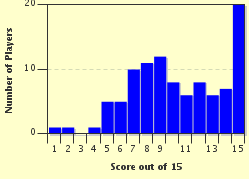Quiz Answer Key and Fun Facts
1. In order to win office at the beginning of the third millennium, a US presidential candidate must receive votes from 270 out of how many Electors?
2. What happens if no candidate achieves a majority of Electoral votes?
3. One of the best known cases occurred in 1824, when which President won the general election even though his opponent had a majority of the popular vote?
4. When this candidate lost the popular vote but won the Electoral vote, a country still smarting from war grew so divided that a second Civil War nearly ensued. He also won the Electoral votes from a state without ANY popular votes for him! Who was this lucky fellow?
5. Sometimes you have to lose to win, and sometimes you have to force a draw. This draw exposed a serious issue with the Electoral College. Who ended up tying the Electoral votes in the election of 1800?
6. After Franklin D. Roosevelt, no US Democratic President won a popular majority until President Obama's election. True or false?
7. A third-party candidate can really cost votes. Among the three-way races below, who did NOT win the majority popular vote (though he won in the Electoral College)?
8. In many U.S. Presidential elections with more than two parties, no one wins a majority of the popular vote. Who is an exception, getting a popular majority despite challengers from the National Republican and the Anti-Masonic parties?
9. Even without a third-party candidate to muck things up, a candidate might receive only a plurality of popular votes or even practically tie with one's opponent yet soundly win the Electoral College. Below are some examples; who's the odd one out, the one who ended up with a majority?
10. Benjamin Harrison had fewer popular votes than Grover Cleveland in 1888, but won in the Electoral College.
11. Those pesky three-way races cause so many Presidents to fail to win over the majority of the people, that maybe it is easier to ask who DID NOT lose to win. In other words, which of these Presidents won a majority popular vote in a THREE-WAY race?
12. In one three-way race, neither major-party candidate got a majority of the popular vote, although one got a plurality. However, the man with FEWER votes ended up winning the Electoral college, even though many citizens felt a proper recount would have given the other candidate another state in the Electoral College and thus the victory. Now that's losing to win! Which election am I talking about?
13. Bill Clinton won two three-way races in the 1990s, at least electorally. If you add up George H.W. Bush's popular votes in 1992 with those of the third-party candidate, a majority of voters voted against Clinton. Who was the spoiler?
14. Below are listed Presidents who served more than one term of office. Which of these candidates did NOT win a popular majority in at least one of the elections listed next to his name?
15. In 2012, President Barack Obama was re-elected. He won in the Electoral College but lost the popular vote, as predicted by many media pundits.
Source: Author
gracious1
This quiz was reviewed by FunTrivia editor
stedman before going online.
Any errors found in FunTrivia content are routinely corrected through our feedback system.

